No, I don’t have a blue screen yet so we can’t do this like a proper weather forecast (don’t worry, we are working on that). However, what we can do is tell you is that law school admissions is in a heavy period of flux: the number of people taking the LSAT as well as the number of people actually applying to law schools is plummeting from highs set during the peak of the recession. In this post we predict the ongoing effects of these trends on law schools and on student’s admissions chances for this application cycle- 2013-2014.
Feel free to disagree strenuously with the predictions made here. That’s what the comments are for.
Prediction #1- The Ongoing Drop in Number of LSATs Administered Will Start to Slow
The LSAT taker slide is approaching it’s bottom. While there will still be a substantial drop in the number of people taking it this year, I think we are nearing a natural floor where the number of people taking the LSAT will stabilize. My guess is that this year and next year we will still see fairly substantial but slowing declines. I’m going to throw out numbers and say that we’ll have a 10% decline from last year and an absolute decline of something around 12K total LSAT takers for 2013-2014 cycle. This will be a change in pace given that the number taking has been falling by 16-17K each of the last years.
Be aware that when making these predictions I’ve got no more information than the chart of recent LSAT administration data, paired with my intuition. It’s roughly what people do when choosing stocks do minus the dart board. However, we already saw a slowing drop in June, where the number taking fell only 4.9% from June of last year (compared with 5.9% the year before). The most recent February administration also marked a slowing decline from the previous year, the first such slow down since the decline started in 2010. That, coupled with the fact that law school becomes an incrementally more attractive option as fewer and fewer people go makes a slowing decline seem likely.
My further guess is that in the future we will see a growing, more educated class of LSAT takers who is willing to take the test and see if they do well enough to get in to schools of their choice, but who will choose not to apply if their results are not satisfactory. For this reason, I predict that in coming years the number of LSAT takers will not decline quite so far as total applicants to law school, and we’ll see a larger gap between the number of people taking the LSAT and the number actually applying to law school.
Prediction #2- Although Law Schools Have Become Less Selective in The Last Several Years, Much of This Change Has Already Happened- Further Change Will Be Slowed as Schools Reduce Enrollment
As the number of total applicants to law schools decline (as they have by double digit percentages each of the last three years) law schools have had two choices to deal with the shortfall. They can either choose to accept weaker applicants to maintain their current levels of enrollment or they can reduce class size to keep standards the same. This year, there has been something of a cascade whereby schools seem more and more inclined to choose the latter option. I predict that this will happen more in 2014-15 even.
The easiest way to think of it is as a lever that has been thrown. Take two similar schools, School A and School B, who are competing with each other in the rankings and are currently ranked the same. Both are faced with a reduced applicant pool and can’t keep applicant numbers as high as in the past year without reducing total enrollment. If School A chooses to reduce enrollment and School B does not, School A is now very likely to do better in the annual USNWR rankings than School B. So if School A reduces class size, School B almost has to- law schools take great pains to avoid rankings drops. When School A and B do it, their other peer school, School C may now have to as well, and so on and so on. These little levers are being pulled everywhere, with the result that more and more schools are choosing to reduce class size rather than accept lower GPA/LSAT numbers.
The other factor is that reducing class size looks like an increasingly smart move given the weak market for law jobs. By reducing total class size, a school may raise its appeal to wary applicants. Also, that school is likelier to have better employment outcomes for its remaining students. As schools are ranked in large part on the basis of employment outcomes, this provides another powerful incentive to reduce enrollment.
However, there is an obvious countervailing reasons why schools want to keep enrollment up: there are tuition dollars to be had. School C in the above scenario may realize that if A and B reduce, they no longer have to, as there may now be enough quality applicants to go around. They let the other two reduce size and reap financial benefits as their enrollment stays up without a major drop in student numbers. Expect to see this cat and mouse game play out repeatedly among peer schools in the coming years.
For a look at the real world, this WSJ piece covers a lot of the planned reductions already taking place. In the main, law schools are very slow to change. It appears that only somewhere between 10 and 20 of the 200 ABA-approved law schools will end up significantly reducing class size in the coming year.
What this ends up meaning is that the bulk of law school will instead continue reducing selectivity in the 2012-2013 (there is no third option except tempting quality students away from competitors with more scholarship money, which most schools are already doing as much as they can). While the enrollment reductions will slow the trend, it’s still likely to continue for the next several years. For the individual applicant, the result is that they are likely to get into some schools that they would not have reached with their numbers in 2008-2009, when applications to law school were at an all time high.
The top 14 schools present a somewhat different picture. Do not expect to see any significant cuts to enrollment in the top 10 schools, as competition to enter these schools remains stern. As usual, these schools will pluck the best applicants from the existing pool. However, given that there has been a disproportionate drop in the amount of LSAT takers with very high (170+) scores, these schools are easier to get in to now than ever. Even Harvard’s acceptance rate has drifted upward in the past few years, now reaching 15.9% as compared with 11% in 2009.
The following graph, published in the Atlantic, shows the score ranges where LSAT takers fell the most in 2012:

(Source)
Expect it to be another comparatively easy year to get in to the top law schools if you have numbers that may have been considered borderline in the past. It is fairly easy to analyze the changes occurring at any individual school. Search for their acceptance rate over the past few years to see if they are are admitting a greater percentage of applicants. Also check the ABA data to see if there has been any drift in their GPA medians and LSAT 25th percentiles. There is typically news coverage when a school plans to reduce class size or if they are considering it, so search around.



